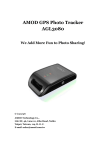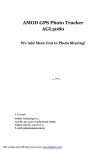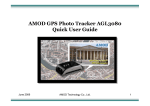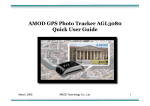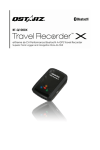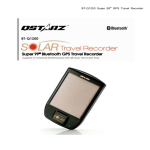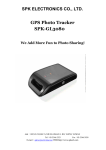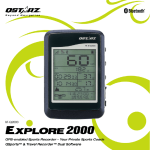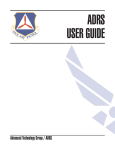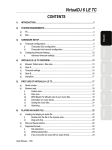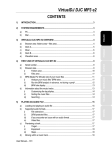Download AMOD GPS Photo Tracker AGL3080
Transcript
AMOD GPS Photo Tracker AGL3080 We Add More Fun to Photo Sharing! © Copyright AMOD Technology Co., Ltd. 8F, 46, Lane 10, Jihu Road, Neihu Taipei, Taiwan, 114, R. O. C. E-mail: [email protected] AGL3080 GPS Photo Tracker – User Manual AGL3080 GPS Photo Tracker Overview AGL 3080 photo tracker is a GPS-based data logger designed to provide location information for digital photos (in EXIF 2.0 or later format) from all DSCs and camera phones. It can help making photo-taking more fun – show not just the great picture but also where it is taken! It is extremely easy to use – just take it along and turn it on with your photo-taking trip. When uploading the pictures to the PC, the accompanying software will do the tagging and saving of GPS location information. After that all you need to do is to click at the GPS-tagged picture and it will show its location on Google Map or other internet maps – let AGL 3080 tag your picture so you can enjoy more! Unique Features z GPS – based on SiRF Star III chipset z Log GPS output in NMEA0183 format at one record per second rate – full rate logging for best time resolution and flexible to use z Standard USB 2.0 interface / Double up as an USB Flash Disk z Works with Windows, Mac, or Linux -based machines z GPS logs can be accessed directly by application software as files, no more awkward COM port set-up procedures z Long operating time – over 15 hours with three standard AAA batteries z Large log capacity – store over 256,000 data records, equivalent to 70 hours of continuously logged GPS data z User-friendly PC-based software is provided for photo tagging (EXIF 2.0 and later format) z Tagged photos can be viewed on Google Map and other internet maps z Works with many on-line tools such as JetPhoto, GPSVisualizer, etc. August 2007 v.02 AMOD Technology 1 AGL3080 GPS Photo Tracker – User Manual In Case You Don’t Know Yet - What is GPS? GPS is a 24-satellite network of Navstar navigational satellites that transmit signals to users, giving them an accurate position in three dimensions along with a time stamp. While it was originally developed in the 1970s as a navigational aid for submarine-based Trident nuclear missiles, its commercial use has expanded well beyond vehicle and hiker navigation to include network timing control for accurate delivery of packet communications. How to use AGL3080 Turn On the Power Depress the POWER ON/OFF button for one (1) second until all three LED’s blink simultaneously once. Then the Green LED (GPS Status) will be lit. This indicates the device has been turned on and starts to search GPS satellites. Power ON/OFF button When sufficient numbers of GPS satellites are found and the position can be fixed, the Green LED will begin to blink, indicating good GPS signal reception and GPS data is being logged Now you can concentrate on and enjoy taking photos! Turn Off the Power To turn the power off, just depress the POWER ON/OFF button again for about three (3) seconds. All three LED’s will be lit once and then off, and the device is now turned off. Status LED’s There are three status LED’s on AGL3080 – Red (Storage Full), Green (GPS Status), and Amber (Battery Power). August 2007 v.02 AMOD Technology 2 AGL3080 GPS Photo Tracker – User Manual Status LED The Green LED is the GPS Status LED. It is either constantly on or blinking. Blinking indicates good reception of satellite signal and GPS position data is being logged. Constant on indicates satellite signal reception is poor and position can not be fixed and logged. To get a good reception of GPS signal, adjust the orientation of the AGL3080 device to ensure it is facing open sky. Normally, after adjustment, the position can be fixed very quickly and the GPS Status LED (Green) will again blink. The Red LED is the Storage Full LED. When the storage space runs out, the Red LED will be on and no more GPS data be logged. If this happens, turn the device off, download the logged data to the computer and clean up the storage disc. The storage disc can be cleaned either by deleting file(s) from the computer or by performing a CLEAN DISC operation when turning the AGL3080 device on. Please see instructions below about CLEAN DISC. The Amber LED is the Battery Power LED. The Amber LED will blink when the battery power level becomes low (< 20% of full power). It is just a warning sign about battery power level is getting low. The device still functions properly. But when the battery power level is too low for the device to function normally, the Amber LED will change from blinking to constant on, and both the GPS and data logging functions will be turned off. When this happens, please turn the device off and replace battery immediately. Special Functions MARK button Position Mark A position can be marked using AGL3080 if the “MARK” button is firmly depressed once. The device will insert a MARK tag to the logged GPS position data. If you depress the Mark button right after taking a picture, the accompanying GPS Photo Tracker software will use this “marked position data” to tag this picture. GPS Reset During normal operation, you can depress the “MARK” button for about three to four (3 August 2007 v.02 AMOD Technology 3 AGL3080 GPS Photo Tracker – User Manual ~ 4) seconds to reset the GPS – the AGL3080 will re-start the GPS satellites searching without using satellite information already on-hand and stored internally. Because the set of GPS satellites data (the orbital and status information) will be valid only for around two hours, they need to be updated regularly. These information are location-dependent – at two far enough locations the GPS receiver will see different set of GPS satellites, hence different satellites date. GPS receivers assume the on-hand internal satellites data is valid and will use it first in searching and tracking satellites. wrong satellite data is used, the searching will take a long time or even fail. If The GPS Reset function thus can help speed up the position fix operation if the device was used previously at place(s) far away from the current location or over some time (> two hours) ago. Disc Reset A “DISC RESET” operation can be performed to clean up the storage space. When turning the device on, depress both the POWER ON/OFF button and MARK button simultaneously and all three LED’s will start to blink. For about 10 seconds, the LED’s will be alternatively on/off, indicating the storage is being cleaned up. At this time you can release the buttons. When this process is complete, the LED’s will go off and the GPS Status LED will be on and the device goes to normal operation mode. To Install/Replace Battery The device requires three standard AAA size batteries to operate. NiH rechargeable batteries or alkaline batteries are recommended. [Please note that batteries are not part of the accessories included in the package.] To install or replace battery, please: 1. Flip the device so that the bottom side is up. 2. Find the latch of the battery compartment cover and slide it sideways to release the cover. 3. Pull the cover out to open the battery compartment. The batteries can be easily inserted, but please ensure the correct polarity. WARNING: Wrong polarity will cause permanent damage to the device. A Note on Battery and AGL3080’s Operating Time Batteries have wide range of capacity (in mAh) and voltage level (even though they are specified as 1.5 V). These factors will cause variation of AGL3080’s operating time. Please check to ensure the quality of batteries is meeting its specifications. We recommend using 1.5 V and 900 mAh AAA batteries. NiH type battery is recommended when using AGL3080 in a low temperature environment. August 2007 v.02 AMOD Technology 4 AGL3080 GPS Photo Tracker – User Manual How to Use the Accompanying AMOD Photo Tracker Software to Tag Your Photos Installation You can install the AMOD Photo Tracker Software by clicking the Setup button (the setup file) in the included CD-ROM. You can specify which directory to install the Photo Tracker Software. An icon (short-cut) will also be created at the Desktop for easy access to the software tool. [First, you need to download and store the pictures from your DSC to your PC. Usually the DSC has accompanying photo management tools for photo downloading and storage.] Plug the AGL3080 to your PC’s USB port [The AGL3080 must be plugged in to your PC to import / up load the logged GPS data.] Run the GPS Photo Tracker Software, and the following will be up: Import the GPS log from AGL3080 to PC – Then you can import the GPS log by selecting the AMOD Photo Tracker Device. previously imported the GPS log files, you can go to the directory to import them. If you have Multiple log files can be selected simultaneously for import. August 2007 v.02 AMOD Technology 5 AGL3080 GPS Photo Tracker – User Manual Import photos – Go to the directory where DSC photos are stored. Then select photos to be tagged – multiple picture files can be selected, for import. The Photo Tracker will automatically tag the selected photos with the GPS location information. When complete, the photos will be shown in blue color. Those photos unable to be tagged will be shown in red color. Those already have GPS tags will be shown in black color. Those photos that August 2007 v.02 AMOD Technology 6 AGL3080 GPS Photo Tracker – User Manual have been tagged by depressing the “Mark” button will be shown in green color. Please refer to the description about the Position Mark function in page 3 of this User Manual. Time Sync Because the position tagging is done by cross relating the GPS time and DSC time, it is important to find out how much off is the DSC time. In order to improve the accuracy during tagging, a Time Sync function is implemented to offset the difference between GPS time, which is standard time, and the DSC internal time, which may not be accurate and could be off. Accurate offset can reduce error in the geo-location tagging process. Time Sync is an optional function – if the DSC time is accurate enough that the geo-location error is not significant or critical to you, you can skip the Time Sync step altogether. You can conduct Time Sync by clicking the Time Sync icon, a window will pop up for you to enter the DSC time. Check the “Enable Time Sync.” field to begin the operation. The Input DSC Time field is for you to enter the time that will be used to sync with the DSC time. Usually choose a slightly ahead value. When the DSC time reaches this pre-selected time, click Apply so that the DSC Time field is updated (synchronized) to the DSC’s system time. The Photo Tracker Software will use the difference between DSC Time and PC System Time to offset any timing error that could exist. When this is done, just click OK to continue. The Time Sync assumes the PC System Time is accurate. If this is not the case, the PC’s system clock needs to be adjusted first. The adjustment needed to compensate the time difference due to going from one time zone to the other can also be done with Time Sync. However it is a tedious and complicated task – you need to record each time zone and when you were there. When tagging photos, they and the log files must be correlated into groups first. For each group, adjust the time separately using Time Sync. If this process is too tedious for you, when you go on a trip that crosses several time zones, please do not adjust your DSC time at all to avoid the complication/confusion this may cause. Display Pictures on Google Map The GPS tagged pictures can be shown on Google Map by clicking the “Show on Google Map” button. August 2007 v.02 AMOD Technology 7 AGL3080 GPS Photo Tracker – User Manual Multiple pictures can be displayed on the Google Map simultaneously too. This can be done if they are selected simultaneously by clicking photo files while holding the Shift key. Finally click the Save Tagged Photos button to save the geo-tagged pictures for future viewing or sharing. When all are done, exit the AMOD Photo Tracker Software by right-clicking the top frame and select EXIT. [NOTE: We are not responsible for any alteration or deletion of pictures during the operation. Please always save a copy of the picture file as back up if needed.] August 2007 v.02 AMOD Technology 8 AGL3080 GPS Photo Tracker – User Manual More Tools and Applications JetPhoto In addition to the supplied AMOD GPS Photo Tracker, AGL3080 can also be used with JetPhoto, which is a photo organizing and management tool and service provided by Atomix Technologies Limited (©2004 – 2007 Atomix Technologies.) JetPhoto can be used either with Microsoft’s Windows operating system or Apple’s MAC operating system. JetPhoto is included in the AGL3080 CD-ROM as part of the photo organizing and management software tools package. They can also be downloaded from http://www.jetphotosoft.com/web/home/. Other Tools Because the logged GPS data is in the standard NMEA0183 format and saved as text files, with the true generic USB 2.0 interface, AGL3080 is very simple and easy to use directly with many GPS software tools such as GPSVisualizer (©2007 Adam Schneider, [email protected]). The GPS tracks logged by AGL3080 can then be converted into various formats such as GPX, KML, etc. This makes AGL3080 a very powerful and handy tool, not limited only for GPS tagging of photos. August 2007 v.02 AMOD Technology 9 AGL3080 GPS Photo Tracker – User Manual Appendix - Status LED There are three LED’s on the device representing Battery Power (amber), GPS Status (green), and Storage Full (red) respectively. These LED’s can be Off, Blinking, or Constant On, representing the status of the device. Status Battery Color Amber Power State Status Represented Off Normal operation Blinking The battery power level is low, but the device can still function normally. but GPS may take longer time to get a position fix Constant The battery power level is extremely low, the GPS and On data log functions are turned Replace battery immediately GPS Status Green Off Device is turned off Blinking The device is tracking GPS satellites and logging GPS data Storage Red Full Constant The device is in the process of acquiring satellites, GPS On data not yet available Off Storage space available Constant The device is out of storage space On GPS data can not be logged Turn off the device and download the logged data file(s). Perform a DISC RESET operation to clean up the disc storage during Power ON. August 2007 v.02 AMOD Technology 10 AGL3080 GPS Photo Tracker – User Manual Appendix – Preparations Attach the Hanging Strip 1. Un-fasten the strip 2. Inset the hanging strip through the side handle of the device 3. Fasten the strip and the device can be carried conveniently Install Battery 1. Open the bottom cover to reveal battery compartment Please note the orientation of each battery is clearly marked. Incorrect battery placement may damage the device. August 2007 v.02 AMOD Technology 11 AGL3080 GPS Photo Tracker – User Manual 2. Insert Three (3) AAA Size Batteries Either regular or rechargeable batteries can be used. 3. Close the Battery Cover August 2007 v.02 AMOD Technology 12 AGL3080 GPS Photo Tracker – User Manual Problem Solving GPS Status LED stays on / Poor GPS signal reception Sometimes the reception of GPS satellite signal may be poor or blocked. This may happen when inside a building or tunnel, or due to weather condition or the GPS signal is blocked by objects such as buildings, trees, metal shields, etc. When this happens, the GPS Status LED will stay on and no GPS data will be logged. Please check and adjust the orientation and position of the AGL3080 to ensure no blockage and facing open sky. When the AGL3080 can receive GPS signal, the GPS Status LED will resume blinking. If the AGL3080 was used previously at a location far away, perform a GPS Reset operation to force a “Cold Start” of the GPS. The AGL3080 should be back to normal soon and the GPS Status LED will begin blinking again. Missing or lost GPS log file Battery can not be removed while the AGL3080 is still turned on and functioning. If this happened, the power to the device will be out. This power outage will cause the logged GPS data not being properly saved and thus permanently lost. Please exercise caution not to open the battery compartment to remove or change the battery while the AGL3080 is still on and functioning to avoid losing logged GPS data. Battery operating time too short Batteries vary a lot in quality, affecting the AGL3080’s operating time. Please make sure to use quality batteries. We recommend 900 mAh batteries. When using the AGL3080 in a cold environment, please use NiH batteries. Can not turn on the AGL3080 The battery contact may be poor or the battery power level may be too low. This may happen when the AGL3080 was not used for a long time. The leakage in batteries drained the battery power. When not using the AGL3080, please take the batteries out and store them properly to maintain the battery’s power level. If the batteries are too old, replace with new ones. August 2007 v.02 AMOD Technology 13 AGL3080 GPS Photo Tracker – User Manual Hardware Specification GPS Chipset SiRF Star III high performance low power GPS receiver IC Frequency L1 1,575.42 MHz Channels 20 parallel tracking channels GPS Tracking Sensitivity - 158 dBm LED Indicators Power On/Off Amber GPS Fix Green Memory Full Red General Storage Capacity 128 Mbytes (1 Gbit NAND flash memory) Interface USB 2.0 full speed Battery 3 AAA standard size batteries Operating Time > 15 hours continuous operation (3 AAA 900 mAh rechargeable battery @ 25℃) Operating Temperature - 20 ~ 50 ℃ Storage Temperature - 30 ~ 80 ℃ Humidity 95 % non-condensing Dimension 90 mm × 45 mm × 23 mm Weight ~ 50 g (not including battery) August 2007 v.02 AMOD Technology 14 AGL3080 GPS Photo Tracker – User Manual Certifications CE, FCC, VCCI certified, RoHS Compliant FCC Notices This Device complies with Part 15 of the FCC rules; operation is subject to the following two conditions. (1) This device may not cause harmful interference and, (2) This device must accept any interference received. Trademarks and Copyrights Windows is registered trademark of Microsoft Corporation. Mac is registered trademark of Apple Inc. JetPhoto is registered trademark and copyrighted by Atomix Technologies Corp. GPSVisualizer is registered and copyrighted by Adam Schneider, [email protected] The AGL3080 and AMOD is registered trademark of AMOD Technologies Co., Ltd. AMOD Technology Co., Ltd. 8F, 46, Lane 10, Jihu Road, Neihu Taipei, Taiwan, 114, R. O. C. E-mail: [email protected] August 2007 v.02 AMOD Technology 15
















